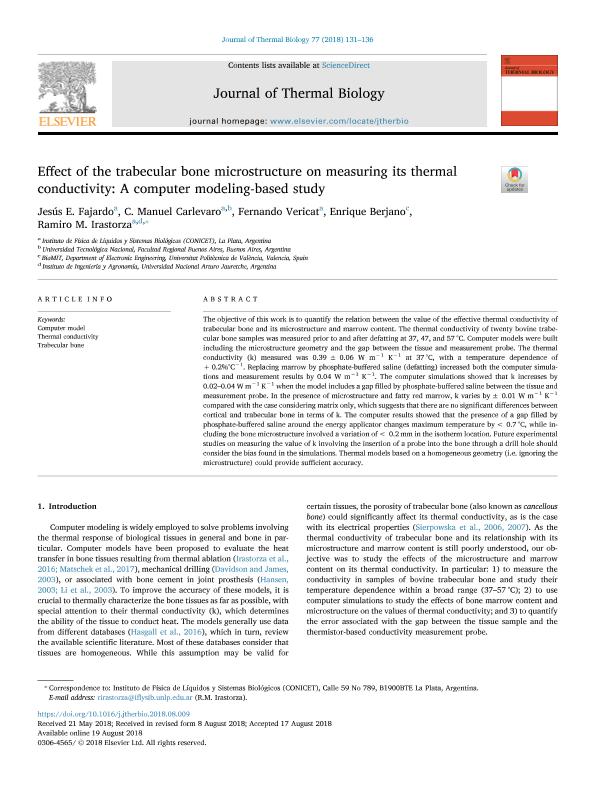Mostrar el registro sencillo del ítem
dc.contributor.author
Fajardo Freites, Jesús Ernesto

dc.contributor.author
Carlevaro, Carlos Manuel

dc.contributor.author
Vericat, Fernando

dc.contributor.author
Berjano, Enrique
dc.contributor.author
Irastorza, Ramiro Miguel

dc.date.available
2019-12-02T14:12:47Z
dc.date.issued
2018-10
dc.identifier.citation
Fajardo Freites, Jesús Ernesto; Carlevaro, Carlos Manuel; Vericat, Fernando; Berjano, Enrique; Irastorza, Ramiro Miguel; Effect of the trabecular bone microstructure on its thermal conductivity: measurements and a computer modelling-based study; Pergamon-Elsevier Science Ltd; Journal of Thermal Biology; 77; 10-2018; 131-136
dc.identifier.issn
0306-4565
dc.identifier.uri
http://hdl.handle.net/11336/91075
dc.description.abstract
Objective: Computer models have been proposed to evaluate heat transfer in bone tissues resulting from thermal ablation, mechanical drilling, or associated with bone cement in joint prosthesis. The lack of knowledge of the influence of microstructure and marrow on the effective thermal conductivity of trabecular bone makes these modeling less accurate. We conduct experiments and computer simulations in order to quantify it. Approach: Thermal conductivities of twenty bovine trabecular bone samples were measured in two states: non defatted and defatted. A two dimensional realistic computer model was built from microscope images of a typical sample. Main results. Temperature dependence similar to that reported for most tissues (+0.2 % ºC-1) was found. The effects of microstructure, marrow content, and the experimental conditions were explained by computer modeling considering only three media: matrix, marrow (pore), and gap (between probe and sample). The inclusion of the gap filled by PBS has implied an increase of the effective thermal conductivity and generates a systematic error that can be disaffected. Computer results have also shown that the presence of a gap around the energy applicator during hyperthermic procedures is negligible (<0.7ºC) when the gap has been full by PBS and practically does not modify the isotherms location. Significance. Experimental studies where thermal conductivity is measured by inserting a probe in the bone through a drill should take our findings into account. Homogeneous tissue models can be considered for simulations of trabecular bone heat conduction using the temperature depence coefficient found in this work.
dc.format
application/pdf
dc.language.iso
eng
dc.publisher
Pergamon-Elsevier Science Ltd

dc.rights
info:eu-repo/semantics/openAccess
dc.rights.uri
https://creativecommons.org/licenses/by-nc-sa/2.5/ar/
dc.subject
COMPUTER MODEL
dc.subject
THERMAL CONDUCTIVITY
dc.subject
TRABECULAR BONE
dc.subject.classification
Tecnología de Laboratorios Médicos

dc.subject.classification
Ingeniería Médica

dc.subject.classification
INGENIERÍAS Y TECNOLOGÍAS

dc.title
Effect of the trabecular bone microstructure on its thermal conductivity: measurements and a computer modelling-based study
dc.type
info:eu-repo/semantics/article
dc.type
info:ar-repo/semantics/artículo
dc.type
info:eu-repo/semantics/publishedVersion
dc.date.updated
2019-10-17T20:13:10Z
dc.journal.volume
77
dc.journal.pagination
131-136
dc.journal.pais
Estados Unidos

dc.journal.ciudad
Amsterdam
dc.description.fil
Fil: Fajardo Freites, Jesús Ernesto. Consejo Nacional de Investigaciones Científicas y Técnicas. Centro Científico Tecnológico Conicet - La Plata. Instituto de Física de Líquidos y Sistemas Biológicos. Universidad Nacional de La Plata. Facultad de Ciencias Exactas. Instituto de Física de Líquidos y Sistemas Biológicos; Argentina
dc.description.fil
Fil: Carlevaro, Carlos Manuel. Consejo Nacional de Investigaciones Científicas y Técnicas. Centro Científico Tecnológico Conicet - La Plata. Instituto de Física de Líquidos y Sistemas Biológicos. Universidad Nacional de La Plata. Facultad de Ciencias Exactas. Instituto de Física de Líquidos y Sistemas Biológicos; Argentina
dc.description.fil
Fil: Vericat, Fernando. Consejo Nacional de Investigaciones Científicas y Técnicas. Centro Científico Tecnológico Conicet - La Plata. Instituto de Física de Líquidos y Sistemas Biológicos. Universidad Nacional de La Plata. Facultad de Ciencias Exactas. Instituto de Física de Líquidos y Sistemas Biológicos; Argentina
dc.description.fil
Fil: Berjano, Enrique. Universidad Politécnica de Valencia; España
dc.description.fil
Fil: Irastorza, Ramiro Miguel. Consejo Nacional de Investigaciones Científicas y Técnicas. Centro Científico Tecnológico Conicet - La Plata. Instituto de Física de Líquidos y Sistemas Biológicos. Universidad Nacional de La Plata. Facultad de Ciencias Exactas. Instituto de Física de Líquidos y Sistemas Biológicos; Argentina
dc.journal.title
Journal of Thermal Biology

dc.relation.alternativeid
info:eu-repo/semantics/altIdentifier/url/https://www.sciencedirect.com/science/article/pii/S0306456518302213
dc.relation.alternativeid
info:eu-repo/semantics/altIdentifier/doi/http://dx.doi.org/10.1016/j.jtherbio.2018.08.009
Archivos asociados
